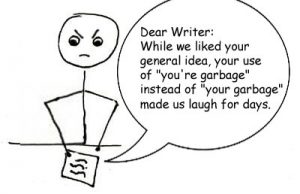
Writers gotta eat, too. And if you’re a writer without a day job in another field, that means selling whatever writing you can produce, wherever you can. Yes, you may be writing the Great American Novel or putting the final touches on the most mind-blowing short fiction ever created, but for some reason, bill collectors don’t seem to take payment in literary genius. So what’s a savvy writer to do?
Write articles. Used to be, articles only had a home in newspapers and magazines. Today, there are millions of websites all looking for content as well. And there’s a writer behind (nearly) every blog post and magazine piece you read. (Yeah, I’m pretty sure there are some robots doing word output too.) How well you can make a living depends on how well you can stand out from the article-writing pack and pitch your skills.
The world of article writing is a little different from pitching a manuscript or piece of short fiction. Instead of sending out a finished, edited piece, you’re more likely to be selling yourself as a skilled expert, ready to write anything needed on Topic X.
Get a free sample proofread and edit for your document.
Two professional proofreaders will proofread and edit your document.
It’s easier than it sounds.
Find Your Targets
What are you an expert in? Gardening? Cameras? Home organization? Radio-controlled cars? Figure out what publications exist in your field, whether a magazine, trade journal, or blog. A quick Google search should help.
Then see if you can find an About Us or Contact page. Often, these will give submissions guidelines, or at least the name of an editor at the publication. When in doubt, try to email the managing editor or the editor of the department for which you want to write (e.g., Food Editor, Gadgets Editor).
Prep Your Attack
If there’s a submissions guide, great! Just follow the rules (Query letter first? Sample article?), and you’re well on your way. If not, familiarize yourself with the publication. It’s easiest to pitch “front of book” items to get a foot in the door, and then try to sell longer features later. “Front of book” means all those short mini-articles you see at the start of a magazine—departments and the like. Offering up a mini-article on “10 Ways to Know It’s Time to Plant Your Begonias” to Plant World Online, for instance, is a great way to prove you know the publication and its audience and to give the editors a way to try you out with little downside.
Don’t write the article yet. Many times, editors will have assignments they need handled or will have a different spin on your suggestion (such as “10 Ways to Keep Your Begonias from Strangling Your Peonies”).
You can always write something to pitch directly, as with a full manuscript, but it helps to be flexible and offer ideas, rather than something set in stone.
Prove Your Chops
Make sure that your query reflects your expertise. Don’t be shy, Let the editors know who you are, why you’re qualified to write for them, and what you’ve written professionally. Attach clips if you have them, especially samples of previously published work in the same field.
 No clips? No problem, we were all there once. Submit the URL of a blog post you’re proud of or something from your student newspaper. Don’t have that? Just mention that you don’t have any formal clips yet, but that you’re happy to provide a writing sample on request. (And don’t forget to have any sample you attach or send professionally proofread). You don’t want to tank your chances by having messed up their/there in the heat of the moment!)
No clips? No problem, we were all there once. Submit the URL of a blog post you’re proud of or something from your student newspaper. Don’t have that? Just mention that you don’t have any formal clips yet, but that you’re happy to provide a writing sample on request. (And don’t forget to have any sample you attach or send professionally proofread). You don’t want to tank your chances by having messed up their/there in the heat of the moment!)
Pull the Trigger
Send that pitch out into the world! You may have to send a whole bunch of pitches to get an interested editor, but, in this case, the blanket approach is worthwhile. You want to be working for as many magazines, blogs, and other publications as you can because a new article writer doesn’t make much money. Later, as you move up to multi-page features commissioned by the editors you’ve worked with, you can scale back a little. For now, though, just get your work out there. It’s always the first step to success!
Kate S.
Get a free sample proofread and edit for your document.
Two professional proofreaders will proofread and edit your document.
Get a free sample proofread and edit for your document.
Two professional proofreaders will proofread and edit your document.
We will get your free sample back in three to six hours!